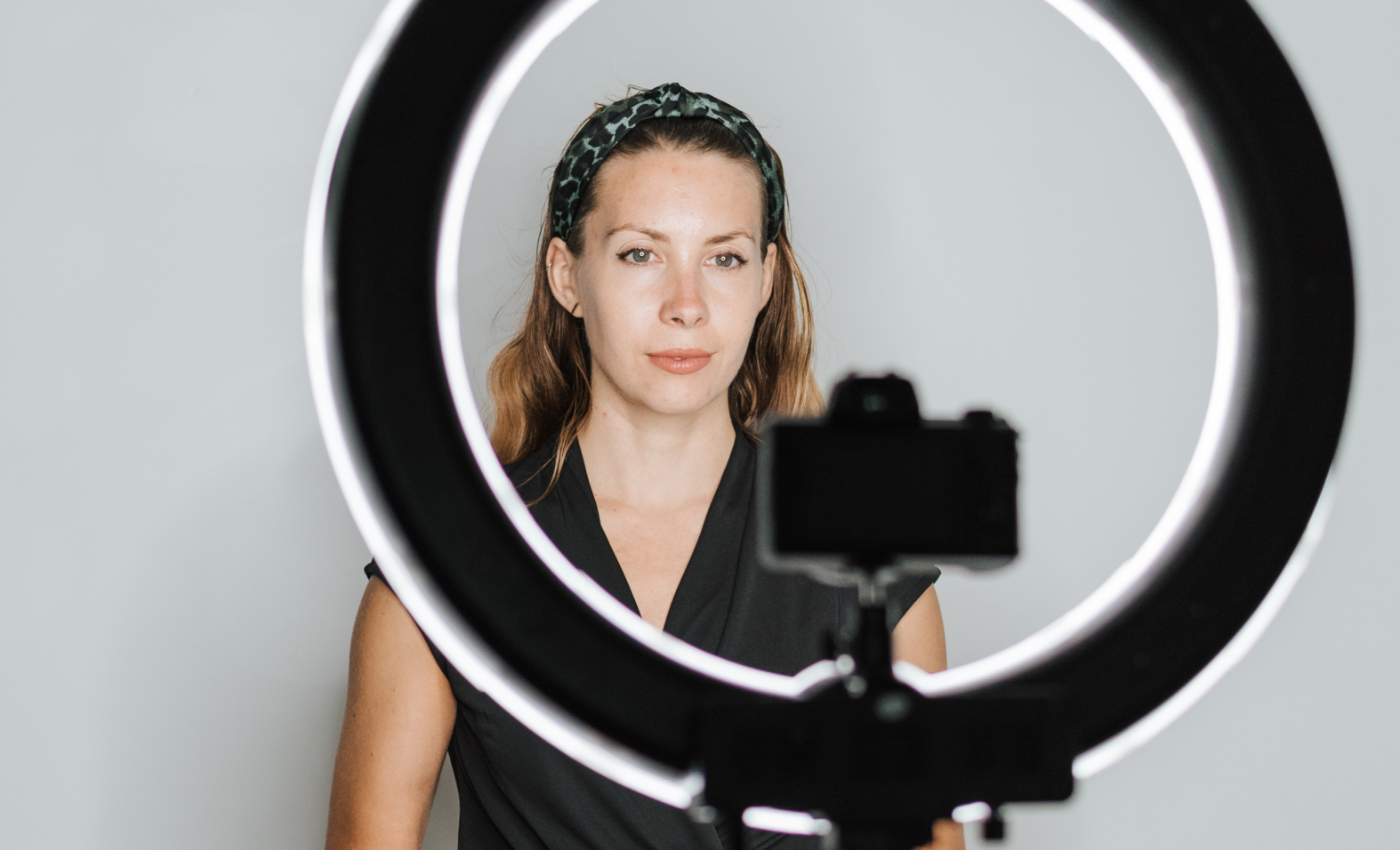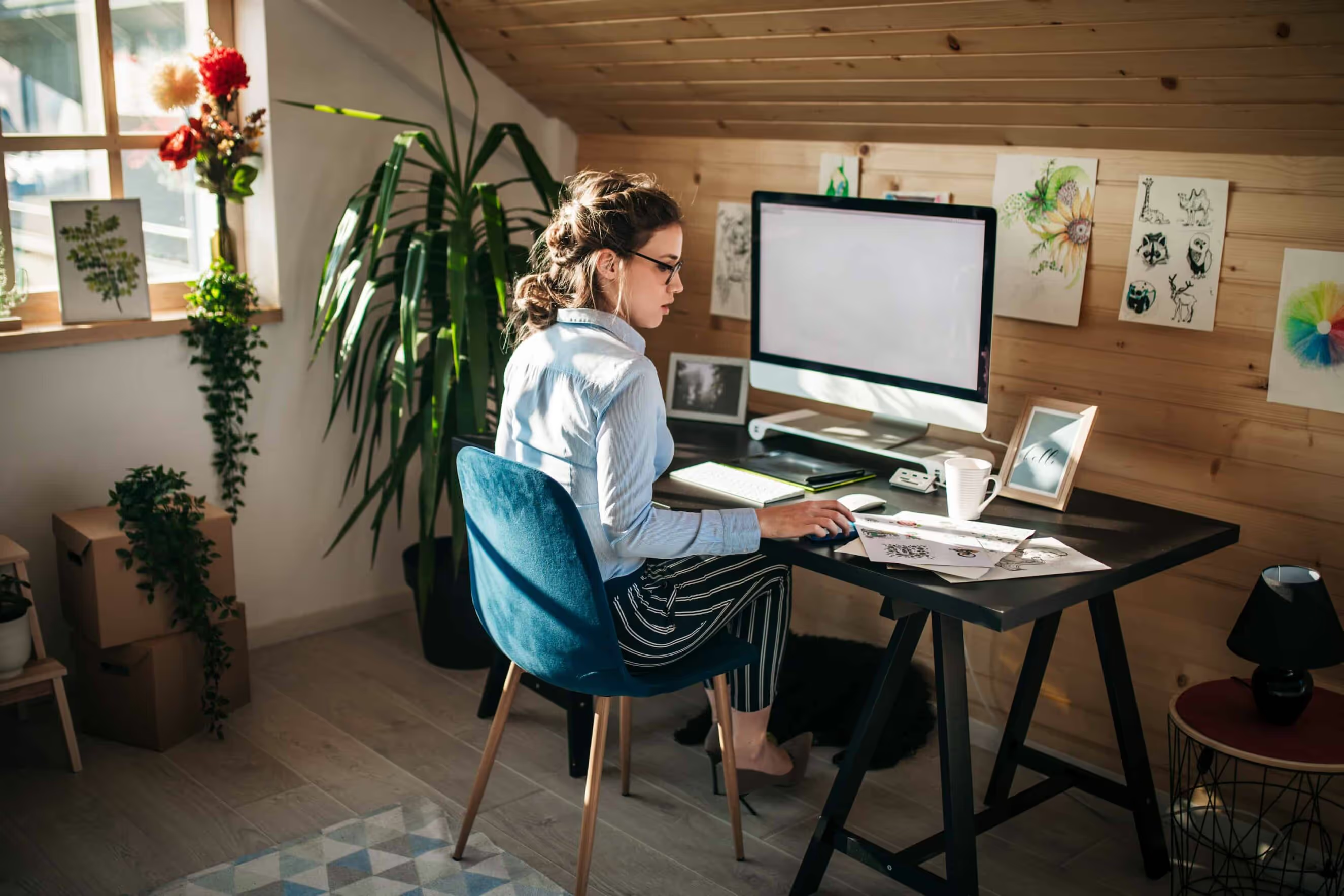Lights, camera, now what? This may be the question you ask yourself when setting out to speak on camera. Whether it’s a Facebook or Instagram live, a webinar, a live stream, or even a course video filmed within the comfort of your own home, it’s easy to overthink talking to the camera.
It can feel uncomfortable talking to an inanimate object that records you, especially one that’s capable of broadcasting to the masses. And when you’re filming content for your online course that your students have paid for, you want to make sure you’re delivering your material clearly and representing your brand professionally.
Because “on-air” gigs are essentially public speaking (America’s number one phobia) in a more controlled environment, it’s important to approach your fears and reservations with as much knowledge and preparation as possible in order to feel comfortable in front of the camera.
Below are some tips and tricks, whether you’re filming live or in front of an iPhone with a tripod, that will make your on-camera experience a bit less strenuous on the nerves and a lot more rewarding.
Practice makes (somewhat) perfect
1. Write a script
This isn’t a Broadway play, so there’s no need to memorize an entire script. But rehearsing from a written text will not only help familiarize yourself with key talking points, but it will also help you organize your thoughts in an order that makes the most sense.
Since the script is written by you and for you—and likely contains material you know well—you get to prioritize and emphasize certain sections or even words that deserve special attention. Allow your mind to create a blueprint of what this looks like, but avoid learning paragraphs verbatim to give room for improv and off-the-cuff remarks that will ultimately show off your personality.
2. Role play
Grab a friend, colleague, or significant other to practice, practice, practice—especially if your “on-air” moment will be part of an interview or will have you interacting with someone else. Have this person also ask you spontaneous questions and cut you off mid-sentence to force you to think on your feet and mirror a natural conversation.
Pro-tip: Never underestimate the power of a full-length mirror for mastering speaking in front of others. If you can’t find a volunteer to help, practicing in front of a mirror will help you to identify the facial expressions, vocal inflections, and body language you’ll want to either highlight or readjust.
3. Test record yourself in different set-ups
If you’re recording a video at home, take time to go around your house or apartment to find a space where the lighting and sound are optimal. Be sure to also play with your camera and tripod setup, keeping your audience in mind and asking questions like:
- Should I shoot this horizontally or vertically?
- Is there anything in this frame that could be distracting?
- Does the angle of the lens make me feel my most comfortable?
Remember: You’re the director of your own shoot and what you say goes.
4. Take two
If you have the luxury of pre-recording, never use your first take. Look back at what you’ve filmed and use it as a reference for what you want to change in the future. Be sure to also note and acknowledge the positive aspects of what was shot and carry these into your next take.
But remember: Don’t strive for perfection.
Do you speak perfectly in everyday conversations with your friends or peers? Of course not. Even news anchors who have the luxury of teleprompters garble their words from time to time. Being human is relatable.
Those who focus too much on perfection come across as robotic and overly rehearsed. While the future of technology is surely exciting, there’s a reason why the voice of Siri hasn’t replaced your favorite content creator. Your audience wants to see part of themselves in you. And when it comes to students watching your course video content, remember: They’re paying for your course because they want to see and hear your unique perspective.
5. Just breathe
Right before you hit record, it’s extremely helpful to run through some breathing exercises to slow down your heart rate and alleviate last-minute jitters.
A favorite technique is the “4-7-8” where you breathe in for four seconds, hold that breath for seven, and then exhale for eight. Feel free to also adapt your favorite breathing exercises from yoga, Pilates, or meditation, and apply them to these stressful moments leading up to “action.”
6. Slow down
Be mindful of the fact that your on-camera talking speed is going to increase due to nerves. Take necessary pauses and enunciate larger words that may come out slurred if not given proper care and attention. This is obviously easier said than done, but incorporate this into your mirror or role play preparation and it will eventually become second nature.
7. Avoid caffeine
Or anything that will make you more tense and shakier than you need to be. If you’re getting ready to record, it’s likely that your body will be powered by adrenaline. Adding caffeine will just exaggerate this enhanced physical state, leading to on-camera no-no’s like speaking too quickly or distracting fidgeting.
8. Drink up and warm up
Dry throat is a symptom of stress. If you’re going to be on camera talking for an extended period of time, your throat may get parched. Ensure you are well-hydrated in advance so those vocal cords can keep up.
Also be sure to integrate classic vocal warm-ups like humming, making lip bubbles, and singing scales to utilize every part of your mouth and lips. Think of your mouth as just another muscle. You stretch your legs before doing squats in the gym, right?
9. The power of distraction
Sing a favorite tune, play a game on your phone, or respond to a few client emails to take your mind off of what is about to take place. Sometimes a quick distraction with a familiar activity can bring a welcomed wave of calm.
10. Bring your best you
You’re likely most comfortable in your favorite outfit or with fresh a haircut—when you’re the best version of you. The same should apply to any on-camera work. You’ll want to wear what makes you feel the most confident because this confidence will undoubtedly radiate from within.
Don’t be afraid to also personalize your look with some bold color, makeup, or jewelry choices. Keep a camera-friendly wardrobe in mind by avoiding fine prints, anything that could make noise, and green (just in case the footage you’re shooting will have graphics). Bring the best version of yourself and your viewers will respect and appreciate this effort.
11. Lighting is your friend
You won’t have to worry about this if you’re on set (studio professionals will have you covered), but lighting is critical for DIY video production. Opt for natural lighting or side lighting for a more cinematic effect. Mastering your lighting and home video setup can all be part of the preparation process when you are going through recorded trial runs. And never be afraid to ask a friend or family member for their honest opinion.
12. Do your research
There is a reason why we look up to certain thought leaders, entrepreneurs, and even celebrities. Many times it’s because we appreciate how comfortable they are in their own skin and envy specific traits that we may personally lack.
Take the time to research interviews from people you respect and admire and study their mannerisms. You don’t want to entirely imitate how they interact and engage, but you should identify which characteristics resonate with you and figure out the parts of your own personality that align and can be showcased on screen.
Pro-tip: Some public speakers are great at peppering in humorous anecdotes when talking about more difficult topics. This is something you can easily do if you feel like your content can be complicated or nuanced at times.
The goal with any video content and appearing on camera is to bring a heightened version of your most authentic self. Nobody likes a copycat, but you can and should be inspired by others to help bring out your best qualities and learn from their on-camera tips. Doing the prep-work to feel comfortable on camera will only help add value to your content, express your POV, and help build your brand.
Join more than 150,000 creators who use Teachable to make a real impact and earn a real income.







